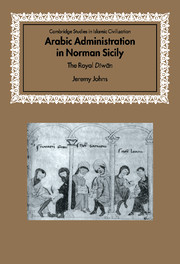Book contents
- Frontmatter
- Contents
- Preface
- Tables
- Abbreviations
- Genealogical table of the De Hautevilles of Sicily
- Note on Measurements
- Introduction
- 1 ‘In the time of the Saracens …’
- 2 ‘When first the Normans crossed into Sicily …’
- 3 ‘Our lady, the Regent Adelaide, and our Lord, the Count Roger, her son’, 1101–30
- 4 The earliest products of the royal dīwān, 1130–43
- 5 The jarāʾid renewed, 1144–5
- 6 The records of the royal dīwān. Part I: the jarāʾid al-rijāl
- 7 The records of the royal dīwān. Part II: the dafātir al-ḥudūd
- 8 The duties and organisation of the royal dīwān, 1141–94
- 9 ‘The people of his state’. The ‘palace Saracens’ and the royal dīwān
- 10 The Norman dīwān and Fāṭimid Egypt
- 11 Royal dīwān and royal image
- Appendix 1 Catalogue of dīwānī documents
- Appendix 2 Provisional catalogue of private documents
- Appendix 3 Abū Tillīs – ‘Old Wheat-sack’
- List of References
- Index
- Titles in the series
7 - The records of the royal dīwān. Part II: the dafātir al-ḥudūd
Published online by Cambridge University Press: 10 March 2010
- Frontmatter
- Contents
- Preface
- Tables
- Abbreviations
- Genealogical table of the De Hautevilles of Sicily
- Note on Measurements
- Introduction
- 1 ‘In the time of the Saracens …’
- 2 ‘When first the Normans crossed into Sicily …’
- 3 ‘Our lady, the Regent Adelaide, and our Lord, the Count Roger, her son’, 1101–30
- 4 The earliest products of the royal dīwān, 1130–43
- 5 The jarāʾid renewed, 1144–5
- 6 The records of the royal dīwān. Part I: the jarāʾid al-rijāl
- 7 The records of the royal dīwān. Part II: the dafātir al-ḥudūd
- 8 The duties and organisation of the royal dīwān, 1141–94
- 9 ‘The people of his state’. The ‘palace Saracens’ and the royal dīwān
- 10 The Norman dīwān and Fāṭimid Egypt
- 11 Royal dīwān and royal image
- Appendix 1 Catalogue of dīwānī documents
- Appendix 2 Provisional catalogue of private documents
- Appendix 3 Abū Tillīs – ‘Old Wheat-sack’
- List of References
- Index
- Titles in the series
Summary
Gàrcia and Ottumarrano (Dīwānī 41)
By August 1175, the boundary-dispute between the peasants of Gàrcia and of Ottumarrano, deep in the very heart of the island, had erupted into open violence. Gàrcia belonged to the church of Cefalù, but Ottumarrano was an estate of the royal demesne, and so Sanson, its bailiff, obtained an official record of its boundary from the royal dīwān in Palermo. When even this failed to settle the quarrel, one of the officers of the royal dīwān was dispatched in person. He was a Greek Christian, and seems to have come from just on the Greek side of the middle of the cultural scale that ran from Sicilian Arab to Sicilian Greek. His Greek name was Eugenios tou Kalou, a name which means literally ‘he who is well-born of the good’, while in Arabic he was Abū l-Ṭayyib, ‘father of the good’, a close equivalent of his Greek name. In Greek he was ‘the secretary Eugenios’, while, in Arabic, with its more elaborate titulature, he was ‘the elder, Abū l-Ṭayyib, lord of the royal dīwān of verification’. He summoned the elders of all the surrounding royal estates to be witnesses before his inquiry into the disputed boundary: thirteen Christians, notaries, priests, and gentlemen, and fourteen Muslims, village head-men and elders, from Cammarata, Casaba, Cassaro, Ciminna, Cuscasino, Gurfa, Petralia, Polizzi, Regaleali, Vicari and Villalba. They assembled on the southern boundary of Gàrcia, and Eugenios called upon them, in the name of the mighty and holy king, to relate everything that they knew about the boundary.
- Type
- Chapter
- Information
- Arabic Administration in Norman SicilyThe Royal Diwan, pp. 170 - 192Publisher: Cambridge University PressPrint publication year: 2002



